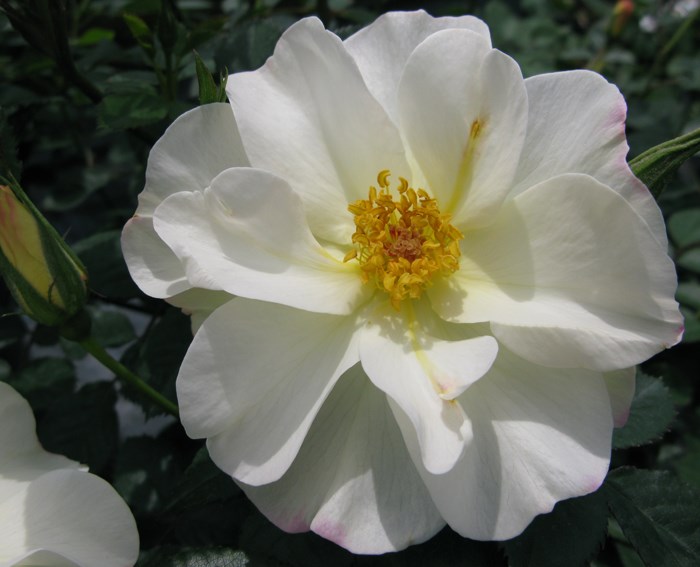For more than a century, Prairie plant breeders have been introducing hardy, disease-resistant ornamental plants. They have literally changed our landscapes – and all for the better. Here are two new shrubs to consider for spring: a stunning white rose and a pink, reblooming, scented lilac. And for those who enjoy acreage living, both are deer resistant!
‘Oscar Peterson’ is the latest rose in the Canadian Artists Series. Named after the great jazz musician who was born in Montreal, Quebec in 1925, its large (4 in. diameter), semi-double flowers are a soft cream colour while in bud, but open to a pure white with a central boss (i.e. prominent, raised cluster) of yellow stamens.
Non-suckering, compact and dense, it is an upright to slightly spreading shrub two feet tall with a spread of three feet. It has deep green, glossy foliage with exceptional disease resistance. A repeat bloomer with slight fragrance, it flowers from spring to fall. One of the hardiest roses to appear in this series, ‘Oscar Peterson’ is rated to zone 3, but well worth trying in protected locations in zone 2.
It does best in full sun in well-drained soil. It is perfect as a specimen for a rose garden or used as a complement in a mixed or shrub border.
History: Award-winning Agriculture and Agri-Food Canada (AAFC) rose breeder Larry Dyck (AAFC Morden Research and Development Centre) crossed ‘Yellow Submarine’ and RSM P02 (a selection of ‘Frontenac’ and a thornless rose developed in Texas.) in about 2007. The Canadian Nursery and Landscape Association rose committee was responsible for evaluating the seedlings and subsequently selecting and releasing the new rose.
‘Pink Perfume’ lilac, developed in the Netherlands, is the latest addition to Proven Winners’ re-blooming Bloomerang lilac series. It blooms heavily in spring on old wood and then, after a short break, it blooms sporadically on new wood from mid-summer through to fall. The reddish-purple buds open into soft pink flowers that have the delightful fragrance that we associate with lilacs. And with it’s reblooming characteristic, that scent wafts through your garden from spring to fall.
With green foliage and a mounded habit, expect a mature height of four to five feet with a spread of five to six feet. Prune just after spring flowering to promote a bushier, dense plant for even more later season blooms. Besides being deer resistant, it is also mildew resistant.
Plant in full sun on well-drained soil. Rated hardy to zone 3, it is worth trialing in protected gardens in zone 2. It’s ideal in a shrub border or as an accent plant and can even used in containers (but plant in the ground in the fall).
Sara Williams is the author of the newly expanded and revised Creating the Prairie Xeriscape; Gardening, Naturally: A chemical-free handbook for the Prairies; and the Saskatoon Forestry Farm Park & Zoo: A Photographic History. Join Sara on two garden tours this summer: May in Great Britain and Iceland (with cohost Melanie Elliott) in July. For more information contact Ruth at [email protected] or 888-778-2378.
This column is provided courtesy of the Saskatchewan Perennial Society (www.saskperennial.ca; [email protected]; NEW www.facebook.com/saskperennial). Check out our Bulletin Board or Calendar for upcoming garden information sessions, workshops and tours.




